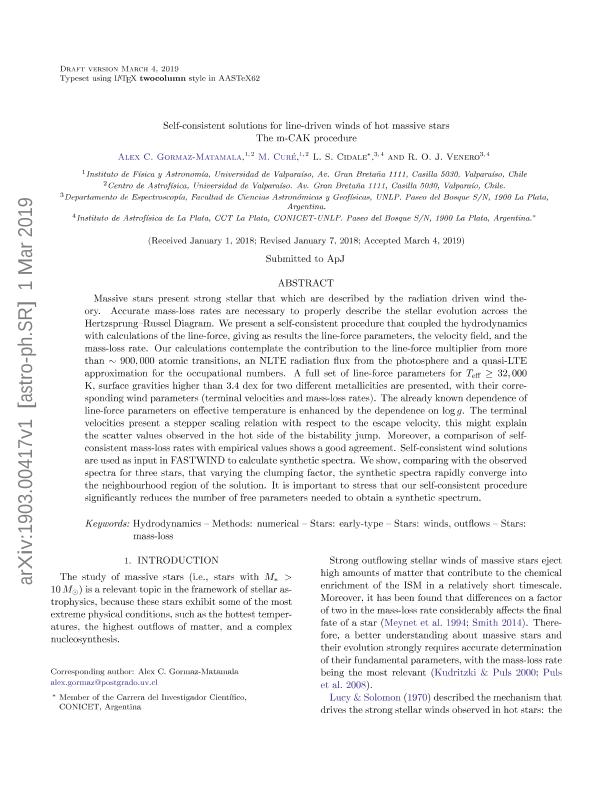Mostrar el registro sencillo del ítem
dc.contributor.author
Gormaz Matamala, Alex C.
dc.contributor.author
Curé, M.
dc.contributor.author
Cidale, Lydia Sonia

dc.contributor.author
Venero, Roberto Oscar José

dc.date.available
2021-11-02T16:23:14Z
dc.date.issued
2019-03
dc.identifier.citation
Gormaz Matamala, Alex C.; Curé, M.; Cidale, Lydia Sonia; Venero, Roberto Oscar José; Self-consistent solutions for line-driven winds of hot massive stars: The m-CAK procedure; IOP Publishing; Astrophysical Journal; 873; 2; 3-2019; 1-16
dc.identifier.issn
0004-637X
dc.identifier.uri
http://hdl.handle.net/11336/145757
dc.description.abstract
Massive stars present strong stellar winds that are described by the radiation driven wind theory. Accurate mass-loss rates are necessary to properly describe the stellar evolution across the Hertzsprung-Russel Diagram. We present a self-consistent procedure that coupled the hydrodynamics with calculations of the line-force, giving as results the line-force parameters, the velocity field, and the mass-loss rate. Our calculations contemplate the contribution to the line-force multiplier from more than ∼900,000 atomic transitions, an NLTE radiation flux from the photosphere and a quasi-LTE approximation for the occupational numbers. A full set of line-force parameters for T eff ≥ 32,000 K, surface gravities higher than 3.4 dex for two different metallicities are presented, with their corresponding wind parameters (terminal velocities and mass-loss rates). The already known dependence of line-force parameters on effective temperature is enhanced by the dependence on . The terminal velocities present a stepper scaling relation with respect to the escape velocity, this might explain the scatter values observed in the hot side of the bistability jump. Moreover, a comparison of self-consistent mass-loss rates with empirical values shows a good agreement. Self-consistent wind solutions are used as input in FASTWIND to calculate synthetic spectra. We show, comparing with the observed spectra for three stars, that varying the clumping factor, the synthetic spectra rapidly converge into the neighborhood region of the solution. It is important to stress that our self-consistent procedure significantly reduces the number of free parameters needed to obtain a synthetic spectrum.
dc.format
application/pdf
dc.language.iso
eng
dc.publisher
IOP Publishing

dc.rights
info:eu-repo/semantics/openAccess
dc.rights.uri
https://creativecommons.org/licenses/by-nc-sa/2.5/ar/
dc.subject
HYDRODYNAMICS
dc.subject
METHODS: NUMERICAL
dc.subject
STARS: EARLY-TYPE
dc.subject
STARS: MASS-LOSS
dc.subject
STARS: WINDS, OUTFLOWS
dc.subject.classification
Astronomía

dc.subject.classification
Ciencias Físicas

dc.subject.classification
CIENCIAS NATURALES Y EXACTAS

dc.title
Self-consistent solutions for line-driven winds of hot massive stars: The m-CAK procedure
dc.type
info:eu-repo/semantics/article
dc.type
info:ar-repo/semantics/artículo
dc.type
info:eu-repo/semantics/publishedVersion
dc.date.updated
2020-11-19T21:58:03Z
dc.identifier.eissn
1538-4357
dc.journal.volume
873
dc.journal.number
2
dc.journal.pagination
1-16
dc.journal.pais
Reino Unido

dc.journal.ciudad
Londres
dc.description.fil
Fil: Gormaz Matamala, Alex C.. Universidad de Valparaíso; Chile
dc.description.fil
Fil: Curé, M.. Universidad de Valparaíso; Chile
dc.description.fil
Fil: Cidale, Lydia Sonia. Consejo Nacional de Investigaciones Científicas y Técnicas. Centro Científico Tecnológico Conicet - La Plata. Instituto de Astrofísica La Plata. Universidad Nacional de La Plata. Facultad de Ciencias Astronómicas y Geofísicas. Instituto de Astrofísica La Plata; Argentina
dc.description.fil
Fil: Venero, Roberto Oscar José. Consejo Nacional de Investigaciones Científicas y Técnicas. Centro Científico Tecnológico Conicet - La Plata. Instituto de Astrofísica La Plata. Universidad Nacional de La Plata. Facultad de Ciencias Astronómicas y Geofísicas. Instituto de Astrofísica La Plata; Argentina
dc.journal.title
Astrophysical Journal

dc.relation.alternativeid
info:eu-repo/semantics/altIdentifier/doi/http://dx.doi.org/10.3847/1538-4357/ab05c4
dc.relation.alternativeid
info:eu-repo/semantics/altIdentifier/url/https://iopscience.iop.org/article/10.3847/1538-4357/ab05c4
dc.relation.alternativeid
info:eu-repo/semantics/altIdentifier/url/https://arxiv.org/abs/1903.00417
Archivos asociados
